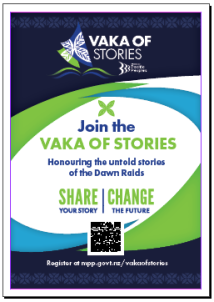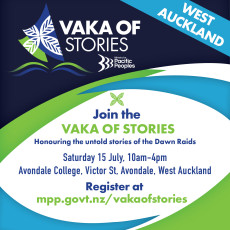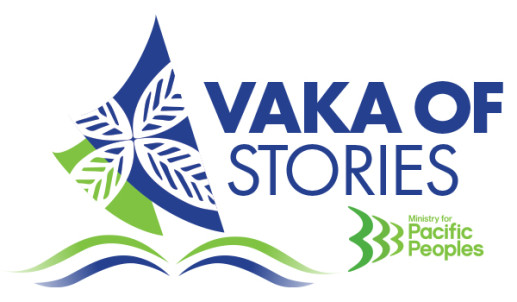Vaka of Stories
Vaka of Stories
A safe space for communities to share their experiences and stories of the Dawn Raids
Background
In June 2021, Cabinet agreed to a formal government apology to Pacific communities for the events of the Dawn Raids. Cabinet also agreed to goodwill gestures to accompany the apology, which included developing a community-facilitated historical account of the Dawn Raids.
The Ministry for Pacific Peoples (MPP) received government funding to facilitate and deliver this Vaka of Stories historical account.
The Vaka of Stories is an initiative intended to facilitate healing by enabling people impacted by the events of the Dawn Raids, both directly and indirectly, to share their experiences in a safe environment.
A ‘Vaka’ will travel around Aotearoa New Zealand to collect stories and experiences of the Dawn Raids from communities. The stories will then be collated into a historical report.
Vaka of Stories launch and malaga
The Vaka of Stories was launched on Thursday 6 July 2023 at the Congregational Christian Church of Samoa EFKS Grey Lynn, 20 Leighton Street, Grey Lynn, Auckland.
Following this event, we will have spaces available across the regions as we would love to have you visit and share your journey with us.
The Vaka of Stories aims to bring our communities together in a safe space to share our Dawn Raids experiences. We understand that sharing this information will be difficult, and we want you to know that our team will be there to listen and support you as you tell us your story in your language. This is a one-on-one Talanoa session with you or your family and friends.
If you want to change the future by sharing your story, we invite you and your family to come to our drop-in centre in Ōtāhuhu or Ōtara this week, where our team will be available to listen and support you as you share your truth.
Below are key dates and locations, including RSVP links to attend:
For information on what to expect at each Malaga stop, click on the 'Vaka of Stories stops - what to expect' tab further down this page.
Christchurch
Date: Saturday 16 September 2023
Time: 10am-4pm
Location: Level 1, BNZ Centre, 120 Hereford Street, Christchurch CBD
Staff will be on hand to welcome and guide you to the correct floor.
Click here to RSVP - Christchurch malaga
Dunedin
Date: Saturday 23 September 2023
Time: 10am-4pm
Location: Pacific Trust Otago, 16 McBride Street, South Dunedin
Click here to RSVP - Dunedin malaga
Past events
- Avondale, West Auckland, Saturday 15 July 2023, 10am-4pm, Avondale College, Victor Street, Avondale
- Ōtāhuhu, South Auckland, Friday 28 July 2023, 10am-4pm EFKS Ōtāhuhu, 60 Station Road, Ōtāhuhu
- Ōtara, South Auckland, Saturday 29 July 2023, 10am-4pm, Le Afio'aga o Aotearoa Peoples Place South Seas Healthcare Clinics, 5 Ōtara Road, Ōtara
- Hamilton, Saturday 12 August 2023, 10am-4pm, Hamilton Methodist Parish, 62 London Street, Hamilton Central
- Wellington Porirua, Friday 1 September 2023, 10am-4pm, TPK House, 12 Hagley Street, Porirua
- Wellington CBD, Saturday 2 September 2023, 10am-4pm, Ministry for Pacific Peoples, Wellington Office, Level 2, ASB Building, 101 The Terrace, Wellington
Share your story and change the future
The drop-in centre is your space to share your story, whether you were directly impacted, or your loved ones were affected. You could also have been affected due to perceptions or attitudes around you that were informed by the Dawn Raids.
You are welcome to come along with your family and friends to support you on the day.
A vaka stop is a full-day drop-in session facilitated locally at either a church or community centre that is accessible to the public. People can join in at any time throughout the session. People will also be encouraged to tell their stories in their own language if they choose to.
A typical vaka stop programme allows people to choose how they want to participate. These components will run at the same time across the day:
- Smaller focus group: This space is designed for people who prefer a smaller group to discuss their stories. Each person is given the opportunity to speak facilitated by a trained facilitator.
- One-on-one session: These sessions are designed for people who prefer to share their stories alone, they can have a support person with them if they need.
- Refreshments and regular breaks: Every stop will have food and drinks served and available throughout the day. There will also be regular breaks and intervals built into the programme.
Support for communities
At every stop and in all three components of a vaka stop there will be a support team and trained facilitators to ensure we meet the objectives of the Vaka of Stories.
- Clinical psychologist and mental health support: To provide mental health support during the session and afterwards if needed.
- Oral Historian: To record the stories to an archival standard that can later feed into a report of the historical account.
- Pacific researcher(s) and experts: To help guide the conversations.
Preparing your story
We’ve developed this step-by-step guide to help you prepare our Dawn Raids stories if you want to create them yourself.
> Download a pdf of this guide
Making a video or audio-recorded story
Step 1: Plan your story
- It is often useful to write some notes or key points to help guide you. This might include information on where you were and when, who was with you, what happened, how you felt, and what impact if had on you and/or your family.
- Gather anything or anyone who might help you to tell your story.
- Plan the length of your story. You will want to keep your recordings manageable and quick to upload. A 1-minute video can be 70mb-100mb, and a 5-minute video between 350-500mb!
Step 2: Find a quiet and comfortable place where you won’t be disturbed
- Video: position yourself where there is soft light facing you, rather than behind.
- Audio: find a comfortable and quiet place to sit. This could be a bedroom with the doors and windows closed.
Step 3: Prepare your device to record (see the tips below)
- Make sure your device is fully charged and check it has plenty of storage space.
- Use a clean, soft cloth to clean your camera lens.
- Close any background apps on your device and switch it to Airplane mode. This will stop notifications, etc., coming through and interrupting your recording.
- Remove your device case and mount your device horizontally on a tripod or other solid surface to keep it stable while recording.
Connect an external microphone if possible. If you have a small microphone, clip it onto clothing on the chest near the speaker’s mouth.
Step 4: Make your recording
- Do a short test recording to check the audio is clear and is a good volume and lighting is good without heavy shadows on your face.
- Include at the start or end of your recording a separate section where you tell us your name and contact information. This will be edited out before it is shared publicly but helps us to keep track of your story during the processing stages.
- Take a few deep calming breaths and shake out your arms and shoulders to relax.
- Record your story and save it somewhere safe and easy for you to access.
Photo/image story
- You can provide hard copies or digital copies of photos/images.
- Create captions for each image. Include:
- the name of the person who created the image (if known)
- if you have the copyright owner’s permission to share the image/s
- date and location where the image was taken/created (approximately)
- name/s of anyone featured in the photo/image
- Write the captions carefully on the back of hard copies.
- For digital images, please supply the original scans and place each into a document with the captions underneath. Include this file with your images when you upload.
Writing a story
- Choose a format and structure that suits you. You may want to handwrite or use a computer or have someone author it for you.
- You may also want to include images or photographs in your story. If so, please include captions with these:
- the name of the person who created the image (if known)
- if you have the copyright owner’s permission to share the image/s
- date and location where the image was taken/created (approximately)
- name/s of anyone featured in the photo/image
- At the end of your story, please include your name, the author’s name (if different), the date written, and your contact details.
Share your stories
- If you would like more information on how to share your stories, please email [email protected].
| Q | The Dawn Raids impacted my grandparents, can I still share my story as a family member? |
| A |
Yes. You can either share about your grandparents’ experience or you can share about your own experience growing up in a family that had endured through the Dawn Raids period. |
| Q | Can I share my story in my own language? |
| A | Yes, you are welcome to share in your own language. You can also bring along a family member or friend if you would like your story translated for those present. |
| Q | I don't want to share my story publicly. Can I share in private during the Vaka of Stories? |
| A | Yes. The Vaka stops will include different sessions including a public session, smaller group sharing and one-on-one story sharing. You are welcome to engage in any session you feel comfortable with. |
| Q | What happens to my story after it's been recorded? |
| A | The stories shared through the Vaka stops will be collected and compiled into a historical record of the Dawn Raids period. |
| Q | What happens to my story if I later decide to withdraw it? |
| A | We understand that for a number of reasons, you may wish to later withdraw your story. Should you wish to withdraw your story from the historical report, please contact the Vaka of Stories team at [email protected]. |
| Q | Where can I see updates about the Vaka of Stories? |
| A | You can find up-to-date information on this webpage and social media channels. You can also contact the team via email at [email protected]. |

Poster:
A3 Vaka of Stories poster (download pdf)

Square social media tiles:
- West Auckland 15 July (download jpg)
- Ōtāhuhu 28 July (download jpg)
- Ōtara 29 July (download jpg)
- Hamilton 12 August (download jpg)
- Porirua 1 September (download jpg)
- Wellington 2 September (download jpg)
- Christchurch 16 September (download jpg)
- Dunedin 23 September (download jpg)

